The Barong and The Kris Dance: Exploring Bali’s Cultural Heritage
If I am asked to choose one dance of Ubud Bali, Indonesia, I’ll probably take more time than expected. Almost all dance forms are expressive and vie for the first spot. However, for me, Barong and Keris dance drama is probably the most prominent of all the Balinese dances. There is a great richness of styles and eloquent drama involved. This was also the first dance performance we saw.
The beautiful island of Bali, Indoensia, is not only blessed with fascinating beaches and outstanding landscapes, but it also has an amazing traditional culture that remains well preserved, highlighting the daily life of its people. Among the myriad of cultural treasures, the Barong and Kris Dance stands out as a captivating spectacle deeply rooted in Balinese mythology and spirituality.
This Barong and Kris Dance Story from Bali has been updated with new and improved content on 17-Oct-2023
Mystique of the Barong Dance Performance
So let’s take you to the mesmerizing world of the Barong dance (and Keris dance), a captivating traditional art form that tells a timeless tale of good vs evil. Originating in Bali, this enigmatic performance embodies the rich Indonesian cultural heritage of the island and is steeped in symbolism and spirituality.
In this travel story, we will unveil the mystique of the Barong and kris dance, exploring its historical roots, intricate movements, and profound significance. As the beating of Gamelan music fills the air, the dancers don elaborate and colorful costumes and masks, transforming into mythical beings that transport the audience into a realm where the forces of good and evil clash.
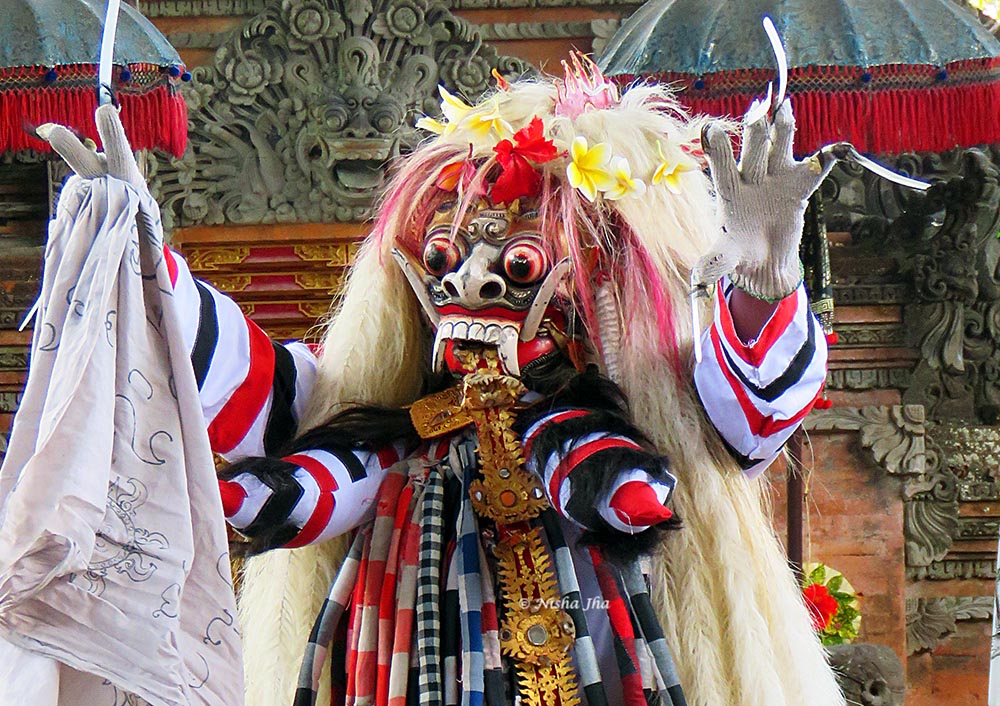
Unveiling the Symbolic Tale of Good versus Evil – Our Experience
The Balinese Barong Dance is story telling by dance, a dance drama, narrating the eternal fight between the good and the evil. This dance is a classic example of Balinese way of enacting mythology, with Barong dance history and myth being blended into one. It involves two main characters Rangda, the ferocious looking witch, and the great beast Barong Ket, a mythical lion like animal with a lot of white thick fur. Lion Barong also looking ferocious, is the king of spirits and protector of the people of Bali, Indonesia. A guardian angel, perhaps.
Barong, a mythical creature representing good, confronts and fights the powerful evil witch Rangda, captivating viewers with its intricate choreography and expressions. But the Barong dance goes beyond entertainment; it serves as a medium for storytelling and spiritual connection. It is believed that during the performance, the dancers channel divine energy, engaging in a spiritual battle that mirrors the struggles faced in everyday life.
He is often represented as a lion with red head, white thick fur, and wearing gilded jewelry adorned with pieces of mirrors. He is also often accompanied by two friendly and funny monkeys.
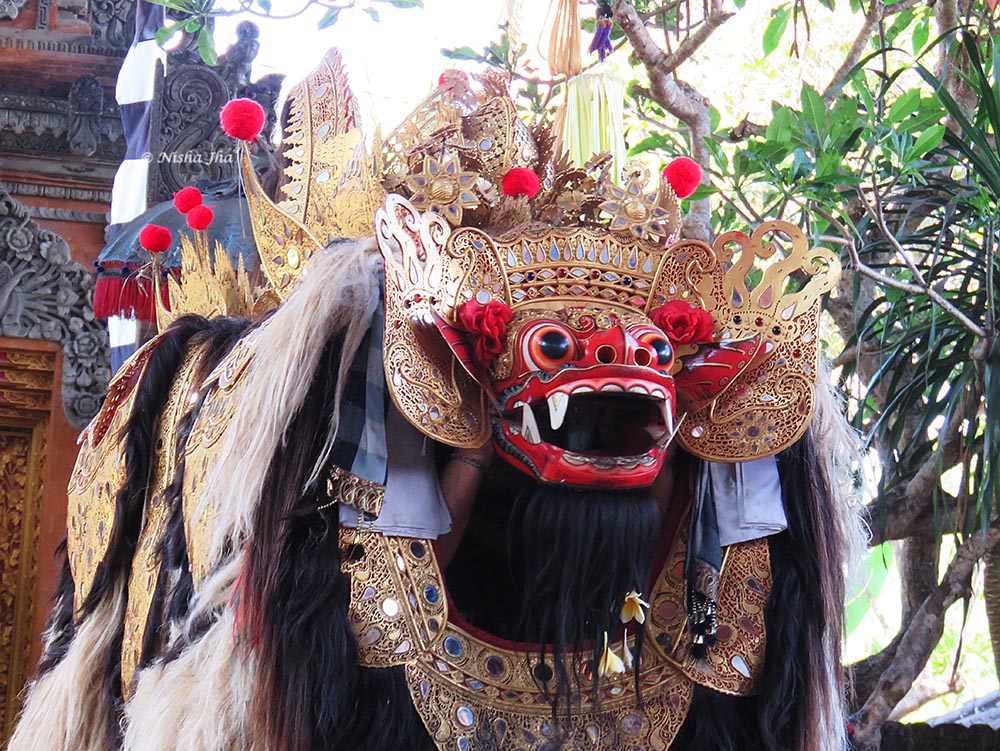
Join us as we delve deep into the world of the Barong and keris dance, sacene by scene, unraveling its symbolism and unraveling its hidden secrets. Get ready to be enthralled by this majestic art form that continues to enchant audiences with its blend of tradition, beauty, and symbolism.
The Welcome
We reached the venue of the Barong performance well on time. Most of the time tickets can be purchased at the venue itself. There were staff assisting us at every step and welcomed and treated us warmly as they ushered us into the open to air auditorium. The seating area was well-organized to accommodate the audience comfortably.
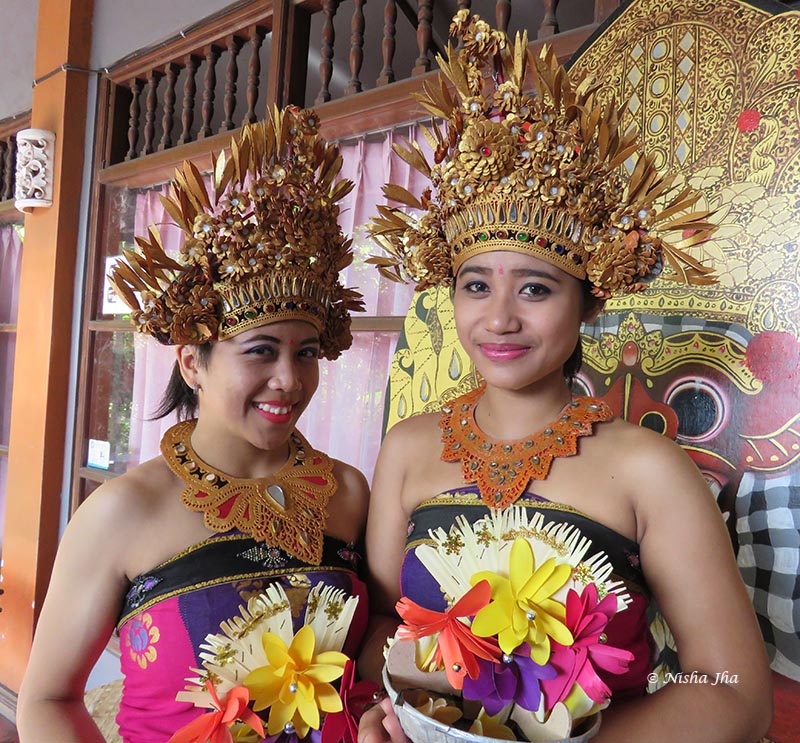
A brief information on what we can expect was given to us in the form of a pamphlet in English.
The staff were dressed in their cultural attire and were quite open to getting a photo with them !
Now to your seats, please! 🙂
The Opening
As the performance begins, the mesmerizing sounds of traditional gamelan orchestra music fill the air, setting the stage for an unforgettable journey. The performers enter the stage with elaborate and colorful costumes, transporting the audience into the heart of Balinese folklore.
Barong’s arrival
The appearance of Barong, the mythical lion-like creature symbolizing good, is a spectacle to behold. The elaborate costume and graceful movements of Barong exude an aura of positivity and vitality. The dance opens with a playful monkey teasing Barong in a peaceful environment. The monkey is fun loving and interacts with the audience also. 🙂
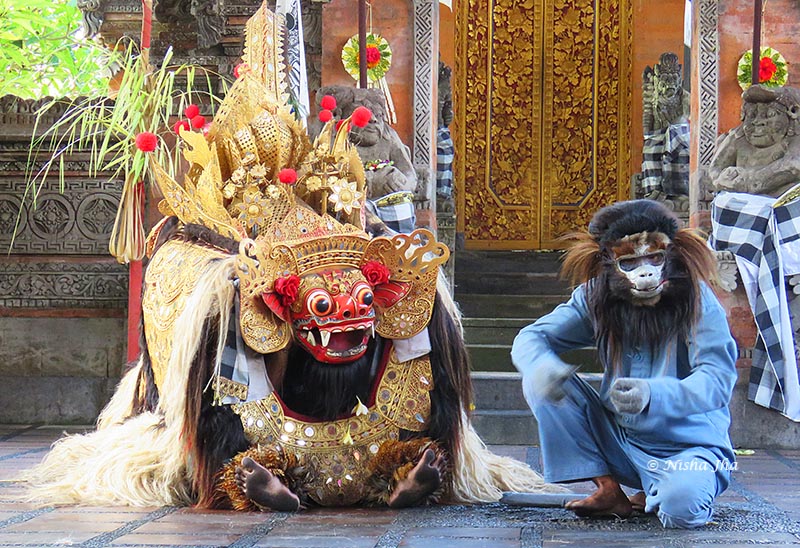
We could discern there were two people wearing Barong’s body and the person in front also working the head. Looking at the mask one can see the chinese influence (or is it the other way around?).
Rangda’s Menace
As Barong exits the stage, after his introduction, the atmosphere changes dramatically when the fearsome Rangda, the menacing witch representing evil, makes her entrance. We had goosebumps, just looking at her. The music was just enhancing the feeling. Her fearsome makeup and eerie presence create an air of suspense and tension.
The story goes that Rangda, the mother of Erlangga, the King of Bali in the tenth century, was condemned by Erlangga’s father because she practiced black magic. After she became widow, she summoned all the evil spirits in the jungle to come after Erlangga. It is also said she was the reincarnation of Calon Arang, the legendary witch who spread fear across Java.
Keris Dance – Soldiers dancing with Krises
Next we see is a scene known as “Keris Dance” performed by male dancers, who represent soldiers of Erlangga.
Next we see is a scene known as “Balinese Keris Dance” (also called the Kris dance), which is a captivating part of the Barong dance presentation. In this enthralling performance, bare chested male dancers brandish krises as formidable weapons and move to the rhythm of the music. These people are perhaps protecting the kingdom. A Kris (Traditional Sword) is a wavy sword with sharp point.
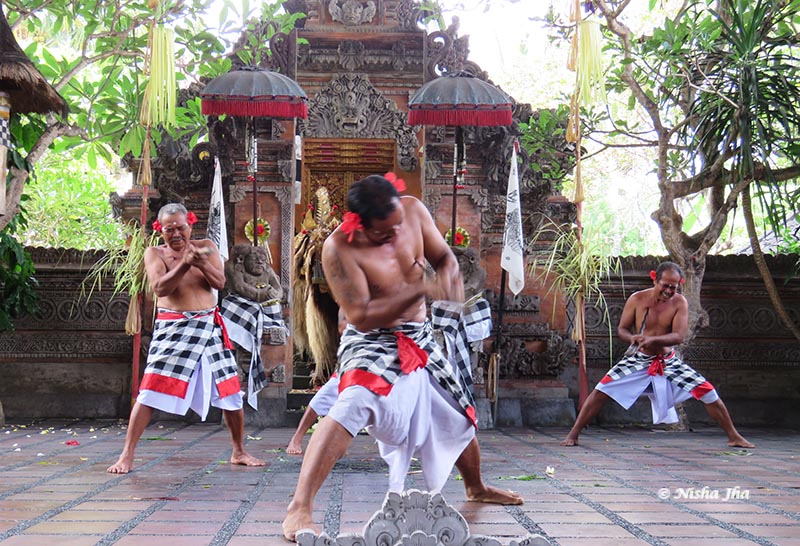
At this point we see that Rangda emerges wreaking havoc. A fight ensues; she and her black magic troops are too strong for Erlangga and his soldiers. Rangda, wielding her dark sorcery and influences Airlangga’s soldiers into a hypnotic trance and wreaks havoc. While in trance the soldiers are commanded to take their lives by stabbing themselves with their Kris swords, in the chest and stomach.
Erlangga calls Barong for help. Barong counters with protective enchantments, rendering the soldiers impervious to the cutting edge of the kris, by creating an invisible shield around the bodies of the soldiers. In their trance-like state, the soldiers appear to pierce themselves with their krises, yet miraculously remain unharmed. We were almost at the edge of our seats, any moment expecting injuries.
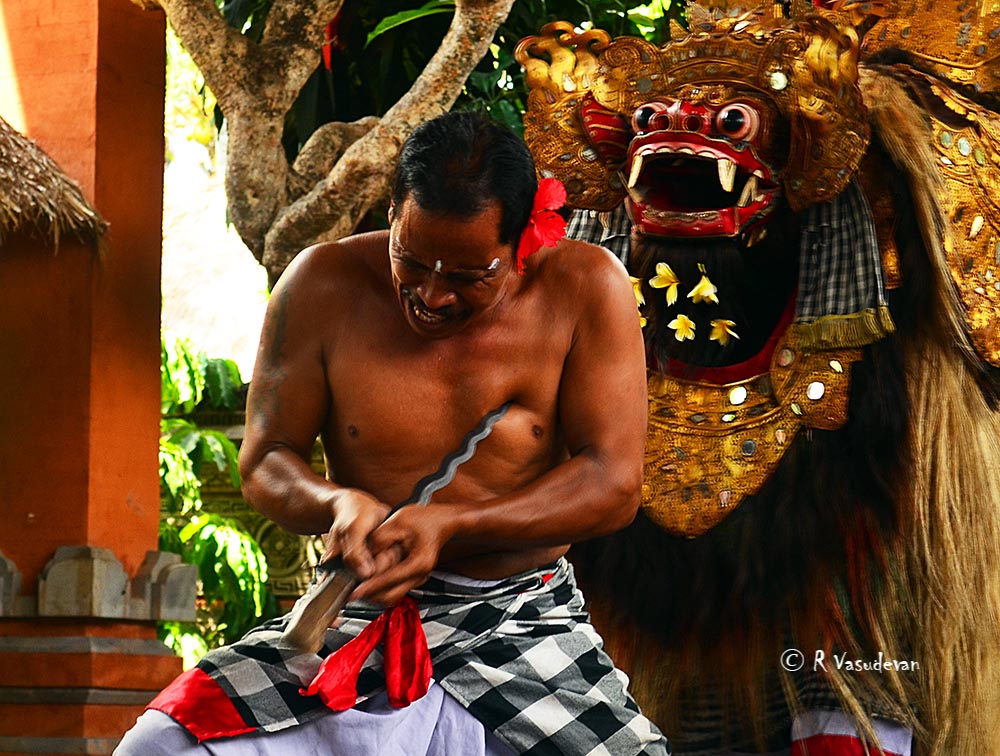
The Epic Battle
In the next scene, the climax of the performance unfolds as Barong and Rangda engage in a dramatic and energetic battle. The performers’ skillful choreography and expressive movements depict the eternal conflict between good and evil.
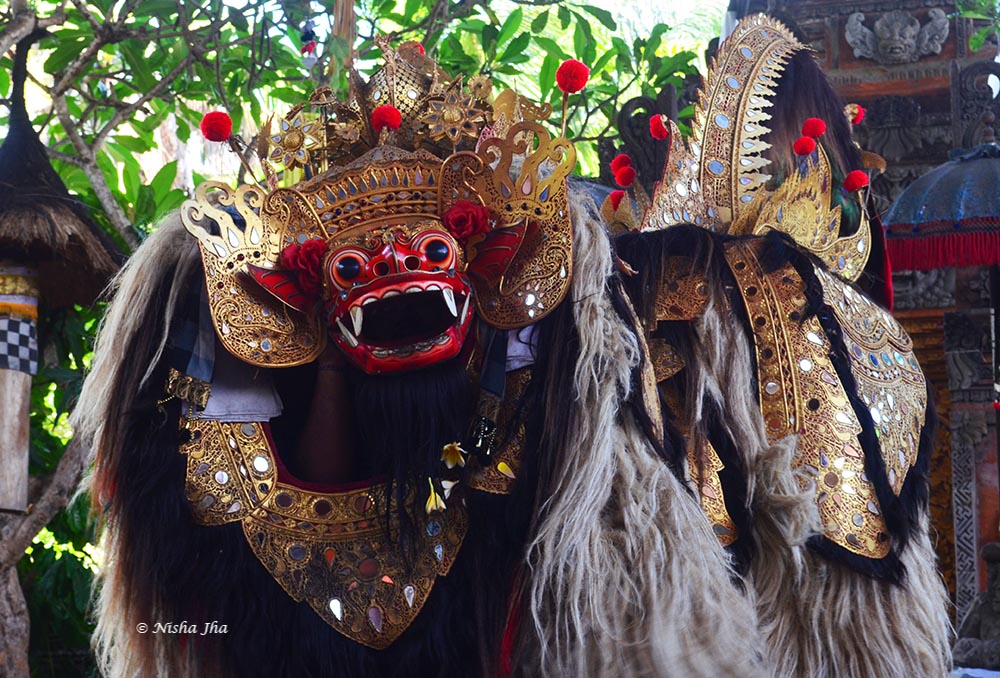
Triumph of Good over Evil
The dance ends with the final battle between Barong and Rangda, with the victory of Barong over Rangda. Rangda runs away and the evil is defeated, filling the audience with a sense of relief and victory. The portrayal of this timeless theme is a cultural treasure.
As the performance draws to a close, the audience is left in awe of the vibrant colors, graceful dances, and powerful storytelling that make the Barong Dance Bali an unmissable cultural experience.
Do you like these kind of dance dramas? Have you seen any? 🙂
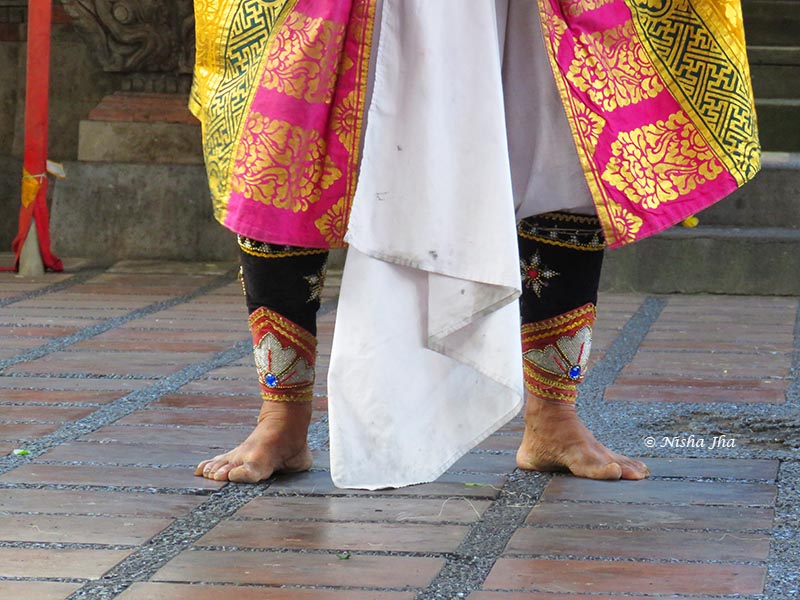
Origins and history of the Barong Dance
The origins of the Barong dance is Balinese traditional dance and can be traced back to ancient Balinese mythology. It is believed that the dance was first performed in the 9th century during the reign of King Erlangga, as a form of spiritual protection against evil spirits. Over the centuries, the Barong traditional dance has evolved and become an integral part of Balinese culture, performed during religious ceremonies and traditional festivals.
The Barong dance is deeply rooted in Hinduism, which is the predominant religion in Bali. It draws inspiration from the epic tales of the Mahabharata and Ramayana, which are considered sacred texts in Hinduism. These stories serve as the foundation for the symbolic battle between good and evil that unfolds throughout the performance.
Symbolism and significance of the Barong Dance.
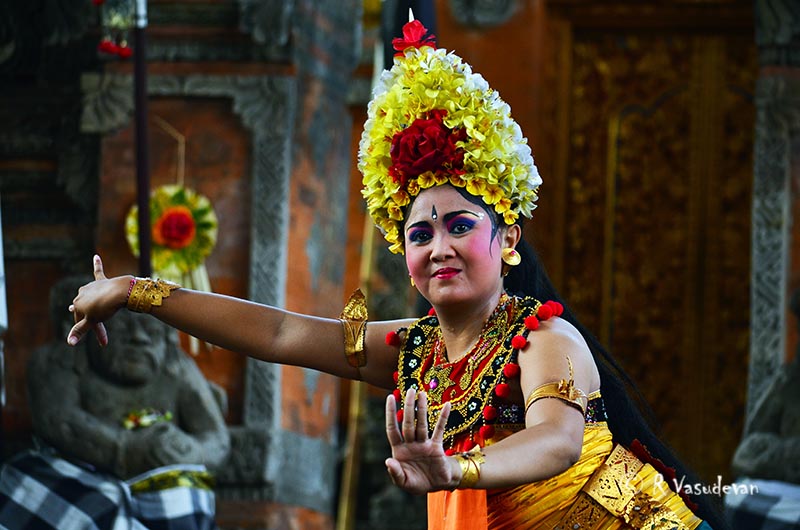
Some people say that Barong Animal Mask Dance is native to Bali and predates the arrival of Hinduism and its influences in Bali island. Its origins could be from animist worship before Hinduism, when villagers still believed in the supernatural protective powers of animals. It refers to a good spirit that took form of an animal as the guardian of forest.
At the heart of the Barong dance lies its profound symbolism and significance. The Barong, a mythical creature resembling a lion or a dragon, represents good and is often regarded as the protector of the island. The Barong is adorned with vibrant colors and intricate designs, symbolizing the vibrant and diverse culture of Bali.
On the other hand, the evil witch Rangda represents the forces of darkness and chaos. She is depicted with grotesque features and a menacing appearance, signifying the destructive nature of evil. The clash between the Barong and Rangda symbolizes the eternal battle between good and evil, with the Barong ultimately triumphing over darkness.
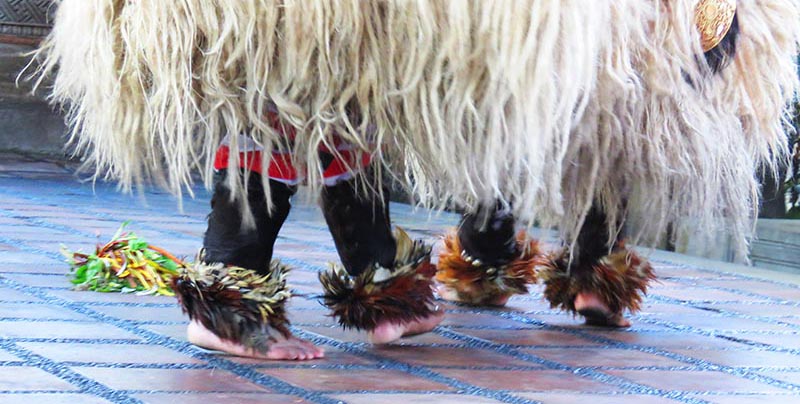
Mythical creatures in the Barong and Keris Dance
The Barong dance showcases a myriad of mythical creatures in Balinese culture that add depth and intrigue to the performance. Apart from the Barong and Rangda, other mythical beings such as monkeys, demons, and gods make appearances, each with their own symbolic significance. The King, his subjects and these characters not only enhance the visual spectacle of the dance but also contribute to the narrative and overall message of the performance and sometimes add a funny moment or two to the performance.
For instance, the monkeys represent mischievousness and playfulness, acting as a contrast to the seriousness of the battle between the Barong and Rangda. The gods, on the other hand, embody wisdom and divine intervention, playing a crucial role in the resolution of the conflict. The inclusion of these mythical creatures in Balinese dance, adds layers of symbolism and depth to the Barong dance, making it an immersive and captivating experience
Barong Dance Costume, Rituals and Symbolism
The dance drama is accompanied by a series of rituals that enhance its spiritual significance. Before the performance, the dancers undergo a purification ceremony to cleanse themselves and prepare for the spiritual battle ahead. Offerings are made to the gods, and prayers are recited to invoke divine blessings.
The costumes worn by the dancers are elaborate and meticulously crafted, reflecting the intricate artistry and attention to detail that goes into the Barong dance. The Barong costume is made from woven fabrics and adorned with traditional ornaments, while the Rangda costume is often made from animal skins and decorated with feathers and shells. The costumes not only enhance the visual appeal of the dance but also play a crucial role in portraying the characters and their symbolic significance.
Beyond its theatrical allure, the Barong Dance holds profound cultural significance. Performances maybe part of ritual ceremonies, showcasing the deep connection between Balinese culture and Hinduism. The dance not only entertains but also serves as a symbolic representation of life’s dualities and the perpetual quest for harmony.
Barong Dance Music
Barong dance music is a captivating blend of traditional Balinese rhythms and sometimes modern beats. This enchanting music accompanies the mythical tale of the Barong, a benevolent lion-like creature, and its battle against evil forces. Experience the rhythmic heartbeat of Bali through the soul-stirring sounds of gamelan instruments, creating an unforgettable journey of culture and folklore. Let the harmonious melodies and vivid storytelling transport you to the heart of Indonesia. Discover the magic of Barong dance music and immerse yourself in a world where tradition and innovation dance hand in hand.
Instruments Used in Barong Performance
Instruments used in Gamelan Ensemble are
- Angklung: a traditional Indonesian instrument, is constructed from bamboo tubes that create harmonious tones when shaken.
- Bonang: a component of gamelan ensembles, comprises a series of small gongs played with mallets.
- Gambang: It is a xylophone-like instrument that contributes to the melody with its wooden bars.
- Gangsa: a type of metallophone, is commonly found in kulintang ensembles and is a part of the musical heritage of the Philippines.
- Gendèr: a metallophone, is commonly used in Balinese gamelan orchestras, contributing to the overall musical experience.
- Gong Ageng: the largest gong within a gamelan ensemble, plays a pivotal role in setting the tempo and structure of the music.
- Gong: is a large bronze disk that serves as the heartbeat of the ensemble, providing a steady and deep resonating sound.
- Kempul: a small gong, contributes to the rhythmic and percussive aspects of gamelan music.
- Kempyang: a small gong, is often employed alongside other gongs in the context of gamelan music.
- Kendang: It is a double-headed drum that sets the rhythmic foundation and drives the dance.
- Kendang: It is a traditional Indonesian drum with two heads, is commonly used to accompany Javanese and Indonesian music.
- Kenong: it is a set of small, horizontally suspended gongs that add melodic layers and depth to the music.
- Ketuk: It is a set of smaller gongs that accentuate the rhythm and provide a higher-pitched timbre.
- Metallophone: A metallophone is an instrument featuring metal bars struck with mallets to produce musical tones, with applications in diverse cultural settings.
- Rebab: a bowed string instrument indigenous to Indonesia, is widely used in traditional Indonesian music.
- Reyong: It is a set of hanging gongs, which are smaller than the kenong, and produce intricate melodic patterns.
- Saron: Saron, an essential element of gamelan orchestras, is a metallophone featuring tuned metal bars that produce melodious sounds.
- Siter: Siter, a plucked string instrument, holds a prominent place in Sundanese music, originating from West Java, Indonesia. In India it is called Sitar.
- Slenthem: a sizable metallophone, is used in gamelan orchestras to produce deep and resonant tones.
- Suling: it is a bamboo flute that provides a beautiful and haunting melody to the ensemble.
- Ugal: The ugal, a gong typically found in Balinese gamelan music, is instrumental in crafting distinct rhythmic patterns.
- Wayang: Wayang is a form of traditional shadow puppetry celebrated in Indonesia, especially in Java and Bali, characterized by intricate, colorful puppets and storytelling.
- Xylophone: The xylophone, recognized for its wooden bars struck with mallets to create musical notes, is a popular percussion instrument.
Dive Deep into the Captivating Barong Dance Story
The storyline of the Barong dance follows a narrative that unfolds through intricate movements and expressions. The performance begins with a lively procession, where the Barong and Rangda make their grand entrances. The Barong, accompanied by his followers, engages in a series of battles with Rangda and her army of demons.
Throughout the performance, the dancers portray the emotions and struggles of the characters through their movements and facial expressions.
The battle scenes are intense and dynamic, captivating the audience with their agility and precision. The story reaches its climax when the Barong defeats Rangda, symbolizing the triumph of good over evil.
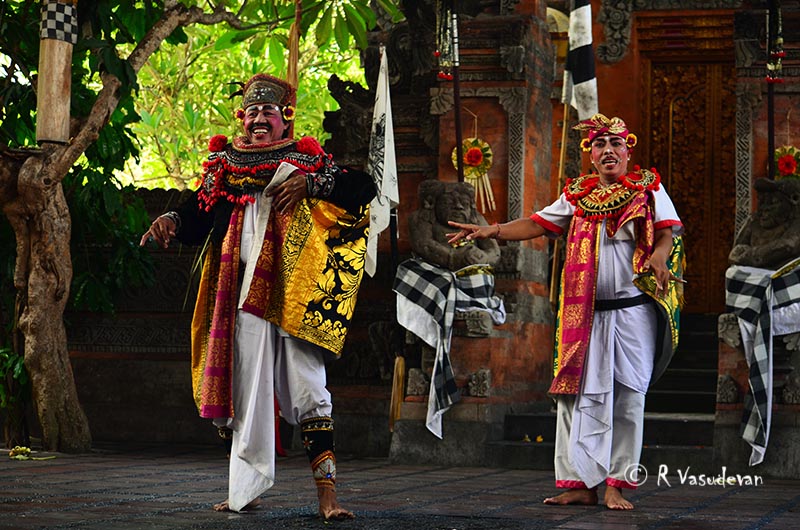
Popular variations of the Barong Dance
The Barong dance has various regional variations across Bali, each with its own unique style and interpretation. Even the story line maybe different. One of the most popular variations is the Barong Ket, which originated from the village of Batubulan. This variation features a larger Barong mask and more intricate choreography, showcasing the skill and artistry of the dancers.
Another well-known variation is the Barong Landung, which is performed by two dancers wearing oversized masks. This variation is often accompanied by comedic elements and is popular during temple festivals and village ceremonies. Each variation of the Barong dance offers a different perspective on the timeless tale of good versus evil, showcasing the diversity and creativity of Balinese culture.
Many other variations exists like Barong Asu – looks like a ferocious wolf or dog, Barong Lembu – features of cow, Barong Macan – is like a tiger, Barong Bangkal (Bangkung) – Old Pig or wild boar, Barong Celeng – or Barong Boar, wild boar, Barong Gajah – looks like an elephant (Gaja = elephant) and Barong Landung – 2 giants, a male and a female. Each of them have a different story but quite interesting.
Cultural preservation and promotion of the Barong Dance
The Barong performance plays a crucial role in preserving and promoting Balinese culture. Efforts have been made to ensure the continuity of this traditional art form, with schools and cultural centers dedicated to teaching the dance to younger generations. The Barong dance is also featured in various cultural festivals and tourism events, attracting both locals and visitors alike.
The promotion of the Barong dance has contributed to the growth of tourism in Bali, with visitors flocking to the island to witness this mesmerizing performance. The economic impact of the Barong dance extends beyond tourism, as it supports local artisans and craftsmen who create the elaborate costumes and masks used in the performance. The continued popularity of the Barong dance has not only preserved Balinese culture but also empowered the local economy.
Impact of the Barong Dance on Tourism and Local Economy
This indonesian culture from Bali can be witnessed in various locations across Bali, with each region offering its own unique experience. The village of Batubulan is renowned for its daily Barong dance performances, where visitors can witness the artistry and skill of the dancers up close. Other popular venues include Ubud, Sanur, and Denpasar, where the Barong dance is often performed during temple festivals and cultural events.
It is recommended to check the local schedules and consult with Bali tourism agencies to ensure you catch a performance of the Barong dance during your visit to Bali. Attending a live performance of the Barong dance is an unforgettable experience that allows you to immerse yourself in the rich cultural heritage of the island.
Where to witness the Barong Dance Spectacle?
You can experience the Barong dance performance in Ubud and other places.
While Barong dance performances are scattered throughout Bali, the Batu Bulan villagers in the Gianyar region and Kesiman, Denpasar, host some of the most popular renditions. These cultural showcases not only entertain but also provide a glimpse into the soul-stirring tales of Balinese heritage.
Please click here to book your Barong Dance Show.
So, the next time you find yourself in Bali, make sure to witness the enchanting Barong dance and immerse yourself in the mystique of this symbolic tale. Experience the beauty, tradition, and spirituality that have captivated audiences for centuries, and gain a deeper appreciation for the cultural treasures that make Bali truly unique.
Useful Information about Bali and the Barong Dance
Tips for an amazing Barong Dance Experience
- Be on time and try to get the front seats. As the dance progresses, it becomes more engaging. There are several fun and laughter moments as well.
- A standard Barong Dance performance usually runs for about 1 hour, offering an immersive cultural experience.
- During peak season, it is better book tickets beforehand or reach the venue early.
- As on October 2023 the exchange rate is 1 USD = 15,800 IDR (Indonesian Rupiyah)
and 1 INR (Indian Rupee) = 190 IDR. - Performers avoid stepping on the offerings, maintaining cultural respect and sanctity and expect the audience to be aware of these.
- Applause is a sign of respect; show your appreciation at the end of the show.
- Visit nearby art markets to purchase Balinese crafts and souvenirs.
- Keep conversations hushed to not disturb the performers and fellow audience members.
- Watch the Gamelan Orchestra: Pay attention to the mesmerizing gamelan music accompanying the dance.
- Read about the Barong Dance’s storyline beforehand to better appreciate the performance. Generally they give out pamphlets at the beginning of the show.
Ticket Prices for Barong and Keris Dance
We experienced the Barong Dance at Sahadewa Barong Dance, one of the oldest troupes in Batubalan.
Keris dance or Kris Dance is part of the overall Barong Dance show and the tickets are inclusive.
Ticket price : The entrance fee for the Barong Dance in Batubulan Village is IDR 150,000 (< USd10) for adults and IDR 75,000 (less than 5 USD) for children.
Book your Bali and Barong Dance tours here
Click on the image to show you options for visiting Barong Dance Show in Bali. These tours include a lot more things to do in Bali Indonesia.
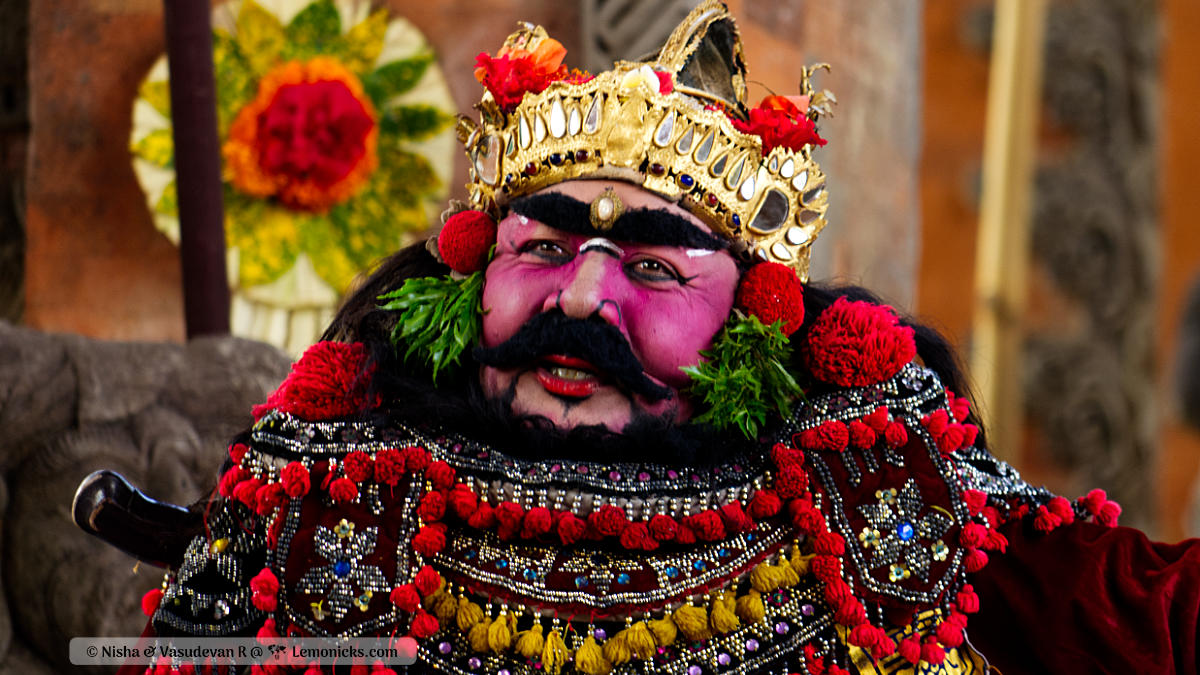

You may also use KLOOK to book your ticket by clicking on the picture above.
How to reach Bali?
Since Bali is an Island, it is best to travel to Bali by air. Denpasar airport (IATA code – DPS) at Bali is well connected to from most countries directly or a maximum of 1 or 2 hops. You may use any of the following portals to check flight options and availability from your city.
Where to Stay in Bali
Discover the perfect Bali getaway! Whether you crave tranquil beaches in Nusa Dua, vibrant nightlife in Seminyak, or cultural immersion in Ubud, we’ve got you covered. Click below for best Bali accommodations to make your tropical dream a reality. Don’t miss out! 🌴🌞🌊🏝️
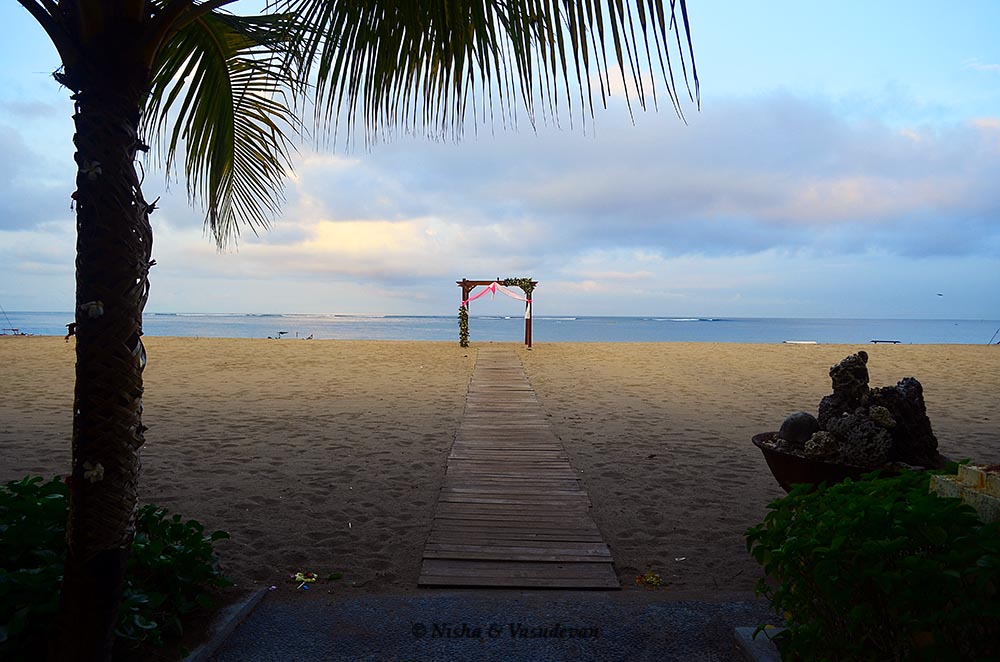
Please click here for accommodation options in Bali to suit all pockets
Tidbits, Snippets and Trivia on Barong Dance Bali
- The Keris dance (Kris Dance) is dangerous, and in February 2021, a 16-year-old male dancer lost his life because he accidentally stabbed himself by his own keris during a Rangda dance in Denpasar, Bali.
- The masks of Barong and Rangda used in the dance performance are considered sacred items, and before they are brought out, a priest must be present to offer blessings by sprinkling them with holy water taken from Mount Agung.
- While the performance may look like a dance to us audience, for Balinese people, it is actually a ritual.
- Similar to Barong, Calon Arang is a legendary and iconic character in Indonesian folklore, in particular Balinese and Javanese folklore. She is often portrayed as a powerful and malevolent witch or sorceress. The story of Calon Arang is commonly associated with traditional theater, dance, and storytelling in Indonesia, particularly in Bali and Java. One may have an influence on the other.
- The Barong Dance’s essence remains intact, with slight choreographic tweaks, reflecting Bali’s timeless heritage.
- Barong Act is one of the top cultural performances in Bali and is not to be missed
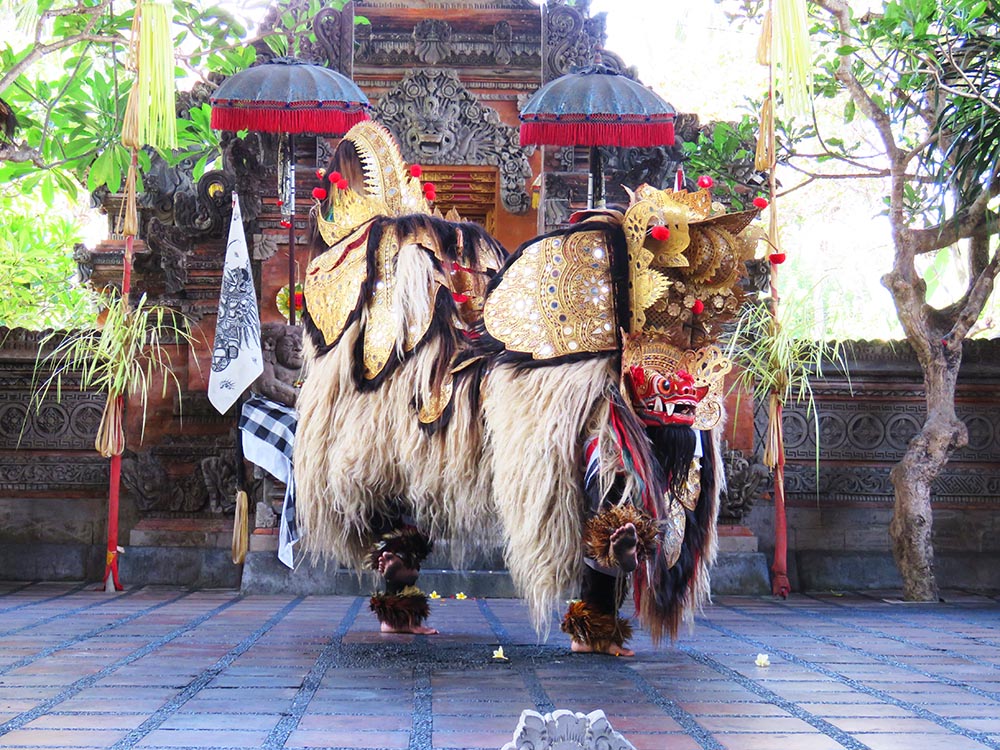
FAQ about Bali and the Barong & Kris Dance
Is English widely spoken in Bali? Do they speak English in Bali?
Yes, English is widely spoken in Bali. While Bahasa Indonesia is the primary language spoken in Bali, English is also commonly used, especially in tourist areas. Bali’s popularity as an international tourist destination has led to a significant number of locals in the hospitality and service industries being proficient in English.
Is photography allowed during the Barong dance performance?
Yes, photography is generally allowed, but it’s polite to ask for permission, as we would anywhere. Even though the administrators may not say anything, our suggestion is please do not use a flash to avoid disrupting the performance.
What is the best time to see the Barong dance of Bali?
The Barong dance is regularly performed, so you can watch it all the year-round. It’s best to check with local venues for specific schedules.
How long does the Barong dance performance last?
A typical Barong dance performance lasts around one hour, including the introductory and main dance sequences.
What should I wear to watch the Barong dance?
Casual and comfortable clothing is acceptable, but it’s recommended to dress respectfully when attending cultural performances in Bali, Indonesia
Are there age restrictions for watching the Barong dance?
No, there are no specific age restrictions, and the Barong dance is suitable for all audiences.
Do I need to book tickets in advance for the Barong dance?
It’s not always necessary to book in advance, but during peak tourist seasons, it’s a good idea to secure your tickets early to guarantee a seat. Please call them in advance and enquire.
Can I interact with the performers after the Barong dance?
While you may not interact directly with the performers, you can often take photos with them after the performance.
Are there any religious restrictions for attending the Barong dance?
There are no religious restrictions, but it’s important to show respect and remain silent during the performance to honor local customs.
Is the Barong dance suitable for children?
Yes, the Barong dance is family-friendly and can be an engaging cultural experience for children, helping them learn about Balinese traditions. It is possible some kids may find the masks a bit overwhelming. Please do take care.
What’s the best way to learn more about Barong dance in Bali?
You may ask us 🙂 or visit local cultural centres, asian art museum, or other museums. A guide would be able to help too.
Is Barong a Hindu God?
No, the Barong is a Balinese mythological depiction of a creature, not a god. It has more to do with Balinese culture than religion.
How heavy is the Barong Costume.
Two people are required to depict Barong. It may be upwards of 40 Kgs but worn by two people.
What are the various types of dances in Bali
Dances in Bali are broadly categorised into 3 types.
Wali – Sacred Dances – Rejang, Sanghyang, Baris Upacara, Kecak dance
Bebali – Semi sacred Dances – Topeng Sidhakarya/Topeng Pajegan, Gambuh dance drama, Wayang Wong dance drama
Balih-balihan – Entertainment Dances – Legong Kraton, Joged Bumbung, Barong Ket dance
Can tourists participate in a Barong Dance performance, or is it a spectator-only event?
Barong performance is one of the top Bali Tourist Attractions. Tourists can actively engage in the experience from their seats only. However sometimes they may be invited to join the dance at the stage towards the end.
Are there any age-old rituals connected to the Barong Dance that remain unchanged?
Certain Balinese rituals and praying for blessings before the performance have stood the test of time, preserving the tradition’s authenticity.
Can you share an interesting anecdote or little-known fact about the Barong Dance?
During performances, some believe that the Barong’s spirit temporarily possesses the dancer, infusing the character with life and energy.
Is there a specific season or time when the Barong Dance is more frequently performed?
The Barong Dance is a year-round cultural attraction in Bali, making it accessible to visitors throughout the year.
What is the meaning of Bali Barong?
Bali Barong is a traditional dance bali depicting a mythological creature in Balinese culture. It is often portrayed as a lion-like creature or a mythical beast with a mask-like face. The Barong is considered a protective spirit and is believed to bring good fortune and protect against evil spirits.
What is the significance of the Barong Dance in Balinese culture?
The Barong Dance holds deep cultural and spiritual significance, portraying the eternal battle between good and evil, and often being performed during ritual ceremonies.
How does the Barong Dance contribute to the preservation of Balinese heritage?
The dance serves as a living testament to Balinese mythology, preserving cultural narratives and traditions through captivating performances that captivate both locals and visitors alike.
What is Taksu?
“Taksu” is a concept in Balinese Hindu culture that refers to a unique spiritual force or power. It is often associated with the energy of the visible world and the blessings of the invisible. Taksu can be described as a ‘talent’ that comes with lifelong training coupled with a gift that comes from a higher place.
In the context of art and performance, Taksu is considered to give knowledge, prestige, and charisma to an artist, making their work more captivating and soulful. It is believed to exist in the human body from birth and can only be developed through hard work and sincerity.
Taksu is not only attributed to human beings or artists but also to the land. For instance, it is often said that it is necessary to preserve the Taksu of the island of Bali, Indonesia.
Photograph Copyright
All photographs used in this article belong to the owners of this website www.lemonicks.com unless otherwise specified. Copying or using them without explicit permission is prohibited and will amount to copyright infringement.
If you want to travel places with us, we invite you to join our feed or Facebook travel page.
P.S.- This article, Bali Barong Dance & Keris Dance Drama in Ubud Indonesia belongs to Le Monde, the Poetic Travels, one of the top Indian Travel Blogs, published by the traveling couple bloggers, Nisha & Vasudevan. Reproduction without explicit permission is prohibited. If you are viewing this on another website other than the RSS feed reader or www.lemonicks.com itself, then that website is guilty of stealing our content. Kindly do us a favour by letting us know via Contact Us. Thank you.
Date first published : 10-Apr-2016
============================================================
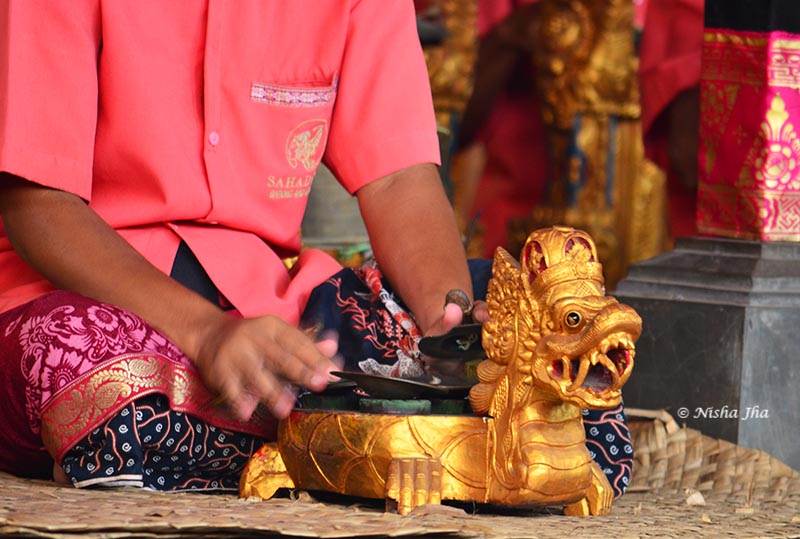
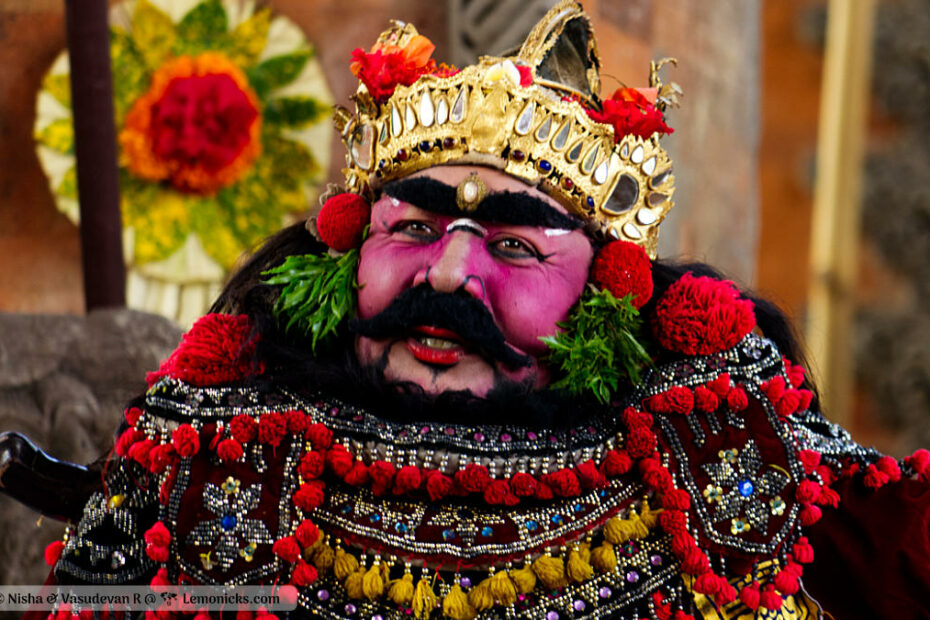





what a lovely colourful tradition… thanks for sharing…
Thanks for reading Archana. 😛
Beautiful ! Revived memories from Bali, though we had mostly seen Legong and missed Barong. I know that lady in the fourth photograph 😀
Thank you.
Glad that it could rekindle your memories. 🙂
I saw that lady in another dance also. 🙂
How colorful! The pictures are beautiful.
How you have described the story, you must have enjoyed it.
I have not gone to Indonesia but it’s on my list now.
Yes, I enjoyed it a lot. In fact I was glued to my chair and eyes were following their movements. 😀
Loved this post Barong is so similar to our Kathakali in terms of the Colorful Costumes and Head-gears and Raam-leela in terms of Story-telling ! When in Bali I am not definitely missing this lovely piece od Art.
Thank you Pooja.
There are many other dance forms in Indonesia which are equally engrossing. 🙂
Lovely colors and photos, Nisha. Colorful costumes are very similar to Yakshagana and/or Kathakali.
Isn’t it? 🙂 I love those colorful costumes. They are always story oriented.
And I haven’t seen any of those two dances.
Beautifully written post !
Thank you Mahesh.
Beautiful costumes and interesting tale of what the dance depicts.
Thank you.
Not only this, but there are other dances in Indonesia which are very expressive & dramatic. 🙂
What a visual delight this entire series is!
The masks and the men feels like a combo of Kerala and Ladakh…
Thank you.
And I haven’t seen any of them. 🙁
Those costumes are so colourful and with lots of details on them. It looks like a coming together of the lion dances and the Kathakali & Yakshagana. Seeing the costumes and these pictures, I wish I could hear the music and the sounds that accompany Barong.
Do you have videos?
I agree they are very colorful!
I liked every bit of dance, costumes, narration and acting.
I haven’t seen either Kathakali or Yakshagana. Now I think I should. 🙂
Yes, I think I have a video too. Will upload sometime.
Thanks.
Really beautiful & expressive…. Thanks for sharing… 🙂
You are welcome.
Beautiful color and costumes..love it
Indeed they are!
Thank you.
Nice pics and story.
We have loads of pics and videos too but none so good and the story, I never understood.
Cheers
Would love to see your pics.
And now you know the story as well. 🙂
Amazing pics.
Thank you.
Thats interesting! My maid is Indonesian so was glad to find out about these traditions.
Oh that’s wonderful!
Did you show her these pictures? Have you picked up some Indonesian language? 🙂
Fascinating! I’d love to be able to see something like this. It’s so interesting that the priest offer blessings when the masks of Barong and Rangda are used.
Yeah, I was also quite impressed by that. 🙂
And I would love to watch it again.
The photos are amazing and this sounds like a great production. The dancing, the story, the masks, and vibrant colors, plus the sacred aspect of it, it all adds up to one amazing experience. No wonder you are such a big fan of Barong.
Thank you very much.
I enjoyed it a lot. Would want to see it again. 🙂
Indonesia has such a rich and vibrant culture! Thanks for sharing this. The photos you took look fantastic!
Thank you !
Yes I agree on Indonesia being vibrant ! 🙂
Barong in the Philippines is a type of clothing for men but hey, I’ve seen this dance in Bali and its really nice.
Ha Ha I didn’t know Barong is name of clothing. 😀 Only cloth that I know which has ‘*ong’ in its name is Sarong. 😛
Awesome! I love cultural dance, reminds me of the Aspara Dance in Cambodia.
Absolutely. Apsara dance is also full of facial expressions . 🙂
This is awesome! You’ve made me really excited about our trip to Indonesia.. will definitely need to experience Barong firsthand. The colors, masks and costumes are fascinating to me!
Thank you.
I am glad I could inspire you. 🙂
This is a wonderful article!
Your photos are fantastic and the story was new for me.
I want to go to Indonesia now. As usual your posts are very inviting.
Thanks.
Thank you for your kind words.
Hope you go there soon.
I loved the different dances I saw in Bali. I especially loved how intricate they were; even the way they moved their hands and feet were important!
Yes absolutely! I tried my best to copy them but couldn’t. It needs practice of years.
Ah! I leave for Bali in 5 days. I’m so excited and one of the things I’m looking forward to are the dances. I’ll have to see if I can find the barong being performed.
Please do that. These dances are performed everyday, you have to inquire and be there on time.
Happy journey! 🙂
And do let me know of your experience of Indonesia.
Wow. This is definitely something I’d be very much interested in seeing! Look at all those expressive and enigmatic faces! Did you know barong in Tagalog is an embroidered dress shirt traditionally used in festive occasions and/or weddings.
More power to you and your travels, Nisha
Hi Trisha,
No, I didn’t know about Barong being used in Tagalog also. 🙂
Next time when I go there, I would like to see a barong. 🙂
The colors alone are enough to get lost in. Beautiful story.
Thank you.
What a different culture altogether. I am reading your blogs one by one. All are seems to be more versatile & interesting as well.
Thank you for exploring our blog! We’re thrilled you find our insights on the Barong dance captivating. Stay tuned for more enriching cultural narratives! Explore our diverse content for further intriguing discoveries.
This sounds absolutely amazing! I love all the colors and movement and the story it tells.
Thank you so much! We’re thrilled you enjoyed the vibrant colors and captivating storytelling of the Barong dance. Stay tuned for more enchanting performances and cultural insights! Explore our site for more immersive experiences.
I love the combination of history, artistry, color, and movement of this. I would love to see it in person one day.
Thank you for your appreciation! Experiencing the Barong dance in person is truly captivating. The intricate blend of history, vibrant colors, and dynamic movements creates an unforgettable spectacle. We hope you get the chance to witness its magic firsthand soon!
The Barong dance sounds like it would be interesting to watch. It’s not something I’ve seen before. I love the awesome colouful costumes that are worn.
Absolutely! The Barong dance is indeed captivating with its vibrant costumes and rich cultural significance. You’d truly enjoy experiencing its mesmerizing performance firsthand. Keep exploring unique cultural dances like this one—they offer unforgettable insights into Indonesia’s artistic heritage!
This is very interesting and I love how theatrical it all is. I would love to watch this dance one day.
We’re thrilled you find the Barong dance fascinating! It’s a spectacular showcase of Balinese culture, and we can’t wait for you to experience its vibrant energy and spiritual storytelling firsthand. Keep following us for more updates on this enchanting tradition! ✨
This is something I would love even as a little girl I love different cultures and national dress and always loved watching dances like this
We’re thrilled you find the Barong dance fascinating! It’s a spectacular showcase of Balinese culture, and we can’t wait for you to experience its vibrant energy and spiritual storytelling firsthand. Keep following us for more updates on this enchanting tradition! ✨
This is interesting, this is the first time. I heard about this but it sounds like a great.
Thank you for your enthusiasm! Witnessing the Barong dance live is a truly magical experience, full of cultural richness and spiritual energy. We hope you get to enjoy this captivating performance that embodies the essence of Balinese tradition soon! 🌟
Such a different world this type of dance. So interesting to find out more about the dance, it looks so interesting x
Absolutely! Barong dance truly offers a captivating glimpse into Indonesia’s rich cultural tapestry. Delve deeper into its mesmerizing movements and symbolic storytelling for an enriching experience. Explore the enchantment of Balinese traditions with us!
The Barong dance performance is truly mesmerizing, and this blog post beautifully unveils its mystique. It’s wonderful to explore the rich cultural heritage of Bali through this traditional art form that symbolizes the eternal battle between good and evil. The detailed description of the performance, the historical roots, and the significance behind it all make for an engaging and enlightening read. The way it transports the audience to a world of mythical beings and forces is truly captivating.
We’re delighted you enjoyed the journey into the mythical world of the Barong dance. Your words capture the spiritual essence and cultural spectacle that make this Balinese tradition a must-see. Thank you for sharing your thoughts, and may you continue to be inspired by the artistic heritage of Bali! ✨
What an interesting history behind this dance. The costumes and makeup are so unique too. I have never seen this before, and it would be neat to see it in person.
We’re glad you’re captivated by the Barong dance! Its unique costumes and makeup are a testament to Bali’s rich cultural tapestry. Don’t miss the chance to witness this spectacular tradition in person – it’s an unforgettable experience! ✨
Wow what an interesting and exquisite experience. Thanks for sharing the history behind the dances…it’s so cool learning about other cultures and the meaning behind their traditions.
We’re glad you’re captivated by the Barong dance! Its unique costumes and makeup are a testament to Bali’s rich cultural tapestry. Don’t miss the chance to witness this spectacular tradition in person – it’s an unforgettable experience! ✨
Wow, your article on the Barong Dance was incredible! It truly captivated my senses and enlightened me about the mesmerizing culture.
Thank you for your kind words! We’re ecstatic that the Barong dance article resonated with you, highlighting the enchanting Balinese culture. Stay tuned for more insights into the world’s vibrant traditions and cultural marvels! ✨
It is a powerful, detail-filled post. I appreciate your time and meticulous description of the traditional dance. I watched this dance on TV. But there’s no comparison to a live show. That’s for sure. The emotionality, the energy in the space surrounding the dancers is beyond words.
Thank you for your heartfelt feedback! Experiencing the Barong dance live is indeed unparalleled, with its vivid costumes and dynamic energy. We’re glad our post could convey a taste of this iconic Balinese tradition. 🌟
Thanks for sharing so much informative details of Barong dance. I’ve watched this dance performance before when I was at Bali , also once at Medan during my trips . It’s so rich culture & art to watch & appreciate it. Cheers SiennyLovesDrawing
It’s wonderful to hear that you’ve experienced the Barong dance firsthand! Your appreciation for Bali’s vibrant culture and artistic expression shines through. Thank you, Sienny Loves Drawing, for celebrating this enchanting tradition with us! 🎭✨
Your article on the Barong Dance has so much detail! So much culture, colors, history! I love it
We’re overjoyed that the vibrant culture and rich history of the Barong dance captivated you! Your enthusiasm for Bali’s colorful traditions is what inspires us. Keep exploring with us for more cultural treasures! ✨
Your detailed descriptions of the dance’s mystique, symbolism, and the epic battle between good and evil were not only enlightening but also added to the excitement of witnessing this performance in person. I appreciate the effort you put into sharing this cultural treasure, and I am eagerly looking forward to witnessing this beautiful dance with my family.
We’re so pleased you enjoyed the article! Experiencing the Barong dance with family will be unforgettable, as it’s a pinnacle of Balinese culture and mythical storytelling. Thank you for your kind words, and may the performance enchant you all! ✨
I find things like cultural dances so amazing and awe-struck, so it’s great to learn more and hear all about it! I’ve never seen this dance in person, but would be amazed.
Absolutely! Cultural dances like the Barong dance are truly mesmerizing. You’re in for a treat when you witness it live! Keep exploring and embracing diverse cultures. 🌟